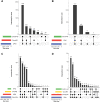CancerVar: An artificial intelligence-empowered platform for clinical interpretation of somatic mutations in cancer
- PMID: 35544644
- PMCID: PMC9075800
- DOI: 10.1126/sciadv.abj1624
CancerVar: An artificial intelligence-empowered platform for clinical interpretation of somatic mutations in cancer
Abstract
Several knowledgebases are manually curated to support clinical interpretations of thousands of hotspot somatic mutations in cancer. However, discrepancies or even conflicting interpretations are observed among these databases. Furthermore, many previously undocumented mutations may have clinical or functional impacts on cancer but are not systematically interpreted by existing knowledgebases. To address these challenges, we developed CancerVar to facilitate automated and standardized interpretations for 13 million somatic mutations based on the AMP/ASCO/CAP 2017 guidelines. We further introduced a deep learning framework to predict oncogenicity for these variants using both functional and clinical features. CancerVar achieved satisfactory performance when compared to several independent knowledgebases and, using clinically curated datasets, demonstrated practical utility in classifying somatic variants. In summary, by integrating clinical guidelines with a deep learning framework, CancerVar facilitates clinical interpretation of somatic variants, reduces manual work, improves consistency in variant classification, and promotes implementation of the guidelines.
Figures






Similar articles
-
Variant Interpretation for Cancer (VIC): a computational tool for assessing clinical impacts of somatic variants.Genome Med. 2019 Aug 23;11(1):53. doi: 10.1186/s13073-019-0664-4. Genome Med. 2019. PMID: 31443733 Free PMC article.
-
Identification of challenges and a framework for implementation of the AMP/ASCO/CAP classification guidelines for reporting somatic variants.Pract Lab Med. 2020 May 31;21:e00170. doi: 10.1016/j.plabm.2020.e00170. eCollection 2020 Aug. Pract Lab Med. 2020. PMID: 32548229 Free PMC article.
-
Clinically actionable cancer somatic variants (CACSV): a tumor interpreted dataset for analytical workflows.BMC Med Genomics. 2022 Apr 25;15(1):95. doi: 10.1186/s12920-022-01235-7. BMC Med Genomics. 2022. PMID: 35468810 Free PMC article.
-
Model performance and interpretability of semi-supervised generative adversarial networks to predict oncogenic variants with unlabeled data.BMC Bioinformatics. 2023 Feb 9;24(1):43. doi: 10.1186/s12859-023-05141-2. BMC Bioinformatics. 2023. PMID: 36759776 Free PMC article. Review.
-
Somatic cancer variant curation and harmonization through consensus minimum variant level data.Genome Med. 2016 Nov 4;8(1):117. doi: 10.1186/s13073-016-0367-z. Genome Med. 2016. PMID: 27814769 Free PMC article.
Cited by
-
Translation of AI into oncology clinical practice.Oncogene. 2023 Oct;42(42):3089-3097. doi: 10.1038/s41388-023-02826-z. Epub 2023 Sep 8. Oncogene. 2023. PMID: 37684407 Review.
-
Development of a Tagmentation-Based Next-Generation Sequencing Clinical Assay as an Alternative to Capillary Electrophoresis-Based Sequencing.Mol Genet Genomic Med. 2024 Nov;12(11):e70035. doi: 10.1002/mgg3.70035. Mol Genet Genomic Med. 2024. PMID: 39560203 Free PMC article.
-
Harnessing Artificial Intelligence in Pediatric Oncology Diagnosis and Treatment: A Review.Cancers (Basel). 2025 May 30;17(11):1828. doi: 10.3390/cancers17111828. Cancers (Basel). 2025. PMID: 40507308 Free PMC article. Review.
-
Copy number alteration features in pan-cancer homologous recombination deficiency prediction and biology.Commun Biol. 2023 May 16;6(1):527. doi: 10.1038/s42003-023-04901-3. Commun Biol. 2023. PMID: 37193789 Free PMC article.
-
Computational approaches for predicting variant impact: An overview from resources, principles to applications.Front Genet. 2022 Sep 29;13:981005. doi: 10.3389/fgene.2022.981005. eCollection 2022. Front Genet. 2022. PMID: 36246661 Free PMC article. Review.
References
-
- Chakravarty D., Gao J., Phillips S. M., Kundra R., Zhang H., Wang J., Rudolph J. E., Yaeger R., Soumerai T., Nissan M. H., Chang M. T., Chandarlapaty S., Traina T. A., Paik P. K., Ho A. L., Hantash F. M., Grupe A., Baxi S. S., Callahan M. K., Snyder A., Chi P., Danila D., Gounder M., Harding J. J., Hellmann M. D., Iyer G., Janjigian Y., Kaley T., Levine D. A., Lowery M., Omuro A., Postow M. A., Rathkopf D., Shoushtari A. N., Shukla N., Voss M., Paraiso E., Zehir A., Berger M. F., Taylor B. S., Saltz L. B., Riely G. J., Ladanyi M., Hyman D. M., Baselga J., Sabbatini P., Solit D. B., Schultz N., OncoKB: A precision oncology knowledge base. JCO Precis. Oncol. 2017, (2017). - PMC - PubMed
-
- Bailey M. H., Tokheim C., Porta-Pardo E., Sengupta S., Bertrand D., Weerasinghe A., Colaprico A., Wendl M. C., Kim J., Reardon B., Ng P. K.-S., Jeong K. J., Cao S., Wang Z., Gao J., Gao Q., Wang F., Liu E. M., Mularoni L., Rubio-Perez C., Nagarajan N., Cortes-Ciriano I., Zhou D. C., Liang W. W., Hess J. M., Yellapantula V. D., Tamborero D., Gonzalez-Perez A., Suphavilai C., Ko J. Y., Khurana E., Park P. J., Van Allen E. M., Liang H.; MC3 Working Group; Cancer Genome Atlas Research Network, Lawrence M. S., Lawrence M. S., Godzik A., Lopez-Bigas N., Stuart J., Wheeler D., Getz G., Chen K., Lazar A. J., Mills G. B., Karchin R., Ding L., Comprehensive characterization of cancer driver genes and mutations. Cell 174, 1034–1035 (2018). - PMC - PubMed
-
- Micheel C. M., Sweeney S. M., LeNoue-Newton M. L., Andre F., Bedard P. L., Guinney J., Meijer G. A., Rollins B. J., Sawyers C. L., Schultz N., Shaw K. R. M., Velculescu V. E., Levy M. A.; AACR Project GENIE Consortium , American Association for Cancer Research Project Genomics Evidence Neoplasia Information Exchange: From inception to first data release and beyond-lessons learned and member institutions’ perspectives. JCO Clin. Cancer Inform. 2, 1–14 (2018). - PMC - PubMed
-
- Griffith M., Spies N. C., Krysiak K., McMichael J. F., Coffman A. C., Danos A. M., Ainscough B. J., Ramirez C. A., Rieke D. T., Kujan L., Barnell E. K., Wagner A. H., Skidmore Z. L., Wollam A., Liu C. J., Jones M. R., Bilski R. L., Lesurf R., Feng Y. Y., Shah N. M., Bonakdar M., Trani L., Matlock M., Ramu A., Campbell K. M., Spies G. C., Graubert A. P., Gangavarapu K., Eldred J. M., Larson D. E., Walker J. R., Good B. M., Wu C., Su A. I., Dienstmann R., Margolin A. A., Tamborero D., Lopez-Bigas N., Jones S. J., Bose R., Spencer D. H., Wartman L. D., Wilson R. K., Mardis E. R., Griffith O. L., CIViC is a community knowledgebase for expert crowdsourcing the clinical interpretation of variants in cancer. Nat. Genet. 49, 170–174 (2017). - PMC - PubMed
MeSH terms
Grants and funding
LinkOut - more resources
Full Text Sources
Medical
Miscellaneous

